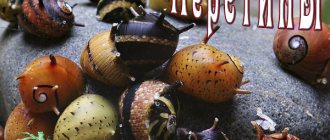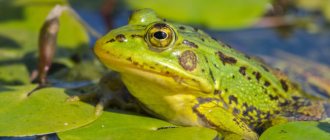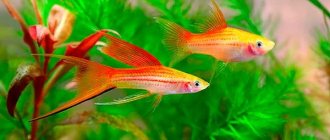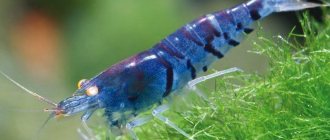Cichlazoma flamingo, otherwise called the pink flamingo cichlid, is considered one of the brightest and most unusual representatives of the Cichlid family. Firstly, its origin is not fully understood and scientists are still arguing where this species came from. Secondly, she has a rather attractive coloring, which makes her stand out from the rest of the family. Whether novice aquarists should get such individuals can be decided after a detailed study of information about them.
Description
There are several theories about the origin of the flamingo species. The main ones are:
- selection from albino black-striped cichlazoma;
- gene and species mutation.
In the first case, most scientists dismiss the theory, since albinos are distinguished by the presence of red eyes and a complete absence of color pigment. These selection criteria are not suitable for the species described.
For this reason, many are more inclined to believe that the flamingo cichlid appeared as a result of a gene mutation. Its main external characteristics are:
- body of short length (from 8 to 15 cm);
- pale pink or intense body color;
- small, neat caudal fin;
- black eyes that stand out well against the background of the pale body shade;
- well developed forehead;
- upper and lower fins displaced behind.
Compatibility
Aquarium flamingos are calm in nature and can get along with many types of fish of similar sizes. Nesm
Despite its peaceful disposition, the flamingo cichlid can still show some aggression, especially during the spawning period. In addition, you should not add small neighbors to them: guppies, shrimps, neons and other babies that they can eat.
Cichlazoma flamingo is one of the attractive fish that does not require too much attention to its content. It will be especially pleasant for beginners to raise not small fish, but such a large and interesting beautiful cichlid.
Maintenance and care
The pink cichlid is one of the smallest representatives of the Cichlid family. That is why a pair of aquarium fish should have at least 50 liters of water. When setting up an aquarium, it is important to observe the parameters of water masses:
- temperature – 25-29°C;
- acidity (pH) – 6.5-8°;
- hardness – 10-20°.
Fish need air for normal existence, and therefore it is important to install aeration filters. The lighting should not be bright; the best option would be diffused light, the presence of dark areas. It is better to use small pebbles as soil, since fish have a habit of digging in the sand, burying themselves in it, uprooting plants. For this reason, the latter are placed in the tank in special pots.
The fish do not require special conditions of maintenance and care, however, it is important to remember that the Cichlov family is aggressive. When raising individuals of the described species with representatives of other families, it is worth adhering to slightly different parameters that are suitable for all inhabitants of the tank. A pair of cichlids living in it will definitely like small artificial labyrinths, snags, and reefs.
Neighborhood selection
Cichlazoma pink flamingo is a peace-loving fish with a calm character. She shows her aggression from males only during reproduction, so it is worth choosing aquarium inhabitants of the same size as neighbors. Ideal compatibility will be ensured if cichlids share the water space in a spacious container with the following fish:
- zebrafish (ladies' stocking);
- small specimens of apistograms (veil butterflies);
- ancistrus catfish;
- curviceps cancer.
But it is not advisable to add small fish (guppies, neons, etc.) to cichlids, because they will quickly be eaten by their larger counterparts, and the large difference in nutrition will not allow them to be kept in the same aquarium.
Cichlazoma pink flamingo is a beautiful representative of the underwater world, which attracts attention not only with its unusual appearance and bright coloring, but also with its ease of breeding, maintenance, and care. Cichlids are perfect for novice aquarists who want to try their hand at raising large aquarium fish.
Feeding
This species of the Cichlid family is omnivorous. The diet of fish should be balanced and varied. That is why, in addition to dry and frozen food, vegetable food is also suitable, such as:
- spinach, carrots, steamed cabbage leaves;
- cereals;
- seaweed.
At least once a week it is necessary to give animals live food:
- bloodworm;
- tubifex;
- earthworms;
- shrimp and other small crustaceans.
Experienced breeders are of the opinion that one feeding per day is enough for fish to live normally.
Fish diet
In its natural habitat, the fish’s daily diet consists of underwater insects, small crustaceans, and algae. Aquarium pink flamingos are also picky eaters; their menu often consists of:
- bloodworms and other zooplankton;
- earthworms;
- well-cooked oat flakes;
- small cereals scalded with boiling water;
- seafood;
- tubifex;
- frozen food.
You can also use special dry bait. Like any other fish, the pink flamingo needs plant foods and vitamin supplements to stimulate the growth and normal development of these representatives of cichlids.
Sex differences
Inexperienced aquarists are unlikely to be able to understand how to determine the sex of the fish presented to them. The main sexual differences between pink cichlids are:
- the presence of a sharp gonopodium in males, while in females it is truncated;
- large size of males;
- the appearance of anal tubercles in males during spawning;
- females are brighter in color and have small shiny spots on their sides.
Reviews
In different bodies of water, black-striped cichlids behave differently and exhibit a specific character. Aquarists have noticed that the brightness of the body color changes depending on the saturation of the lighting. Having created the necessary conditions for black-striped cichlases, there will be no difficulties in keeping them. Gray fish with black stripes need to maintain a constant temperature and a balanced diet. The common tank must have a filtration and aeration system.
Would you like to purchase a Blackstripe Cichlid for your own aquarium? Share in the comments!
Reproduction and breeding
It is a known fact that individuals become sexually mature at the age of 9-11 months. The main breeding period at home is May-September. In order to stimulate steam, it is necessary to increase the water temperature by a couple of degrees. To ensure that spawning goes smoothly, experienced breeders recommend placing it in a separate aquarium.
To understand that the breeding season has begun, it is enough to pay attention to the change in the behavior of individuals. The color of the females becomes brighter, and the males begin to circle around them, attracting the attention of the “ladies”. In addition, individuals become more aggressive towards representatives of other fish species.
The couple usually looks for a secluded place where the female lays eggs several times. After this, the male fertilizes her with milk, and then protects her from enemies. Within a couple of days, the fry appear. For the first five days they should not be fed anything other than what they find in the depths of the yolk sac. When it resolves and the fry go in search of food, it is important to give them “live dust” or Cyclops nauplii.
When breeding fish, it is important not to miss the moment when babies are separated from their parents. As soon as their body length reaches 1 cm, they need to be moved to another aquarium. Otherwise, adults may begin to perceive the cubs as enemies, which will result in them being eaten.
Cichlazoma diseases of flamingos
Flamingos are fish that are not susceptible to genetic diseases and, given a properly organized habitat, maintain a healthy appearance and activity throughout their lives.
In poor water and with insufficient nutrition, a cichlid can develop hexamitosis, also known as hole disease.
The disease manifests itself through damage to the outer integument. The disease can be cured with special medications that are sold in pet pharmacies.
Cichlazomas are fish that attract attention with their appearance, behavior, and unpretentiousness in keeping, breeding, and feeding. Sufficient space, cleanliness, balanced nutrition, diffused lighting, aeration, regular water changes are the main points in growing healthy fish that will delight you with their appearance for a long time.
What other cyclides should I pay attention to?
Today, cichlazomas are species with quite different traits and characteristics.
Nicaraguan cichlisoma
Of course, this is the Nicaraguan cichlisoma - the most brightly colored creature in this niche. The body is almost golden, with the shine of a natural diamond. Plus: sky blue head and gills. And against the background of this splendor there is a bright scarlet belly, setting off the cold shine of gold.
Cichlazoma biocelatum (other names bee, eight-striped) is a very beautiful American cichlid, reaching the maximum beautiful
Cichlazoma biocelatum
coloration by the age of one year. The fry are less brightly colored, calmer and more self-possessed than their parents. If they can still put up with their neighbors in the aquarium, then adult individuals are not so sociable.
A chic (exhibition) option is the citron cichlazoma (not to be confused with cichlazoma labiatum). The calm and self-possessed citron cichlasoma gets angry only if the aquarium is crowded, if it experiences pressure from annoying neighbors. It feeds on small fish, fry and snails.
Citron cichlasoma
Therefore, he likes to live in places with good “infrastructure”: snags, stones,
protruding plant roots. True, when spawning in an ordinary aquarium, they may not retain the romantic yellow-lemon color. The citron cichlid is omnivorous and will not disdain even finely chopped vegetables such as cucumber. Its content does not pose any particular problems.
Cichlazoma labiatum is not only brightly colored (sometimes similar to yellow), but also
Cichlazoma labiatum
clearly visible charisma: it seems that her level of intelligence is high.
She follows her owner with her eyes, communicates with him at her own level, and can even visually ask for food. Cichlazoma labiatum has a second name - lipped. An interesting feature of this individual: when in close contact with the owner, it completely ignores neighboring fish and even representatives of its own species.
Cichlazoma wine
The inhabitant of Brazilian reservoirs, the wine cichlid, is also kind and gentle . Her “trick” is her behavior in case of fright. Freezing, the wine cichlid seems to turn into a dry leaf and fall to the bottom. Thanks to its mimicry coloring, it becomes almost invisible among brown soil and dark algae.
Are bright colors always a sign of cichlids?
With a general feature of having bright, expressive
Cichlazoma albino
coloring, there is an option - an exception to the rule. This is an albino cichlizoma. Confirming the validity of its name, it has no color or even shade .
It is white and transparent in places. She has one more feature: weak immunity and a tendency to disease (the opposite is Sedzhik cichlazoma). Based on this, caring for such fish requires special care and attention.
Dim and type of cichlazoma mezonauta. But this fish has a distinctive dark stripe along its entire body.
Severum representatives have rather discreet colors. In nature they are greenish with a yellow belly. Many bright and presentable color options have been selected for life in an aquarium. The most popular today are severum red pearl and severum striped blue emerald.
Lionhead cichlid
Lionhead cichlid (Steatocranus casuarius)
The lion-headed cichlid (Steatocranus casuarius) is very different from the meeka in its swimming style. When moving, it slightly pushes off from the bottom, moves in jerks or small jumps. This method of movement made it a bottom-dwelling fish with feeding and breathing habits.
The individual is unpretentious in nutrition, unlike the turquoise cichlid. An aquarist shouldn't worry too much. Live, artificial and frozen options are suitable. The fish do not refuse plant foods either. These are not South American cichlids, but, in particular, the blue-spotted acara. External similarity does not confirm the identity of characteristics.
Meeks feel comfortable when the bottom is sandy. Then they like to dig deeper into it, dig up rooted bushes of algae, turn over pebbles, in a word, create a certain “kettle” at the bottom. This is what distinguishes them from shell cichlids, which spend almost all their time hiding in empty shells located at the bottom. There they lay their eggs.
Cichlazoma Red-necked
Red-throats prefer to live in pairs . Even if there are worthy representatives of other fish in the aquarium, the couple separates from them and does not come into contact with them until the spawning period comes and everyone disturbs them.
Cichlasoma mesonauta
In contrast, Cichlazoma mesonauta feels comfortable in groups and gets along even with neighbors such as angelfish . This fact is explained by the timidity of individuals, like Cichlazoma mesonaut. Sometimes, out of fear, they can even jump out of the aquarium if they are in the upper part of the aquarium at the moment of apparent danger.
Particularly original specimens
Auratus Cichlids
The species Auratus should be mentioned in this section. These fish have a second extravagant name: golden parrot. Females and males of Auratus differ significantly in color, which makes the choice easier at the time of pair formation, since the female of Auratus is even more pugnacious than the male. It is interesting that if there is no male in the house (aquarium), the most active and respected female can change her color and become like a male auratus. Auratus does not have the opposite effect.
The southern Malawian reservoir is the place where the blue dolphin originated - a striking representative of the cichlid, strongly reminiscent of the mammal of the same name. The pad on the male's forehead grows year by year, making the fish more and more like him. The success of their home breeding depends entirely on the health of the parents, which requires:
- bright lighting;
- filtering or changing a third of the water weekly;
- maintaining an alkaline pH.
Pseudotropheus Lombardo
A few words about the uniqueness of the Pseudotropheus Lombardo cichlid. It is important that only experienced aquarists can properly maintain a pawnshop. These are beautiful, aggressive individuals, extremely sensitive to changes in water. Female and male Lombardos are so differently colored that they are sometimes mistaken for different species. Lombardos do not get along even with peaceful cichlids.
Three-hybrid parrot - Cichlasoma flowerhorn
Three-hybrid parrot - Cichlasoma flowerhorn. This is the result of the selection work of ichthyologists. In addition to a highly developed bump on the forehead, it is characterized by:
- frequent radical changes in color;
- tendency to loneliness;
- the presence on the scales of a pattern similar to a heart.











